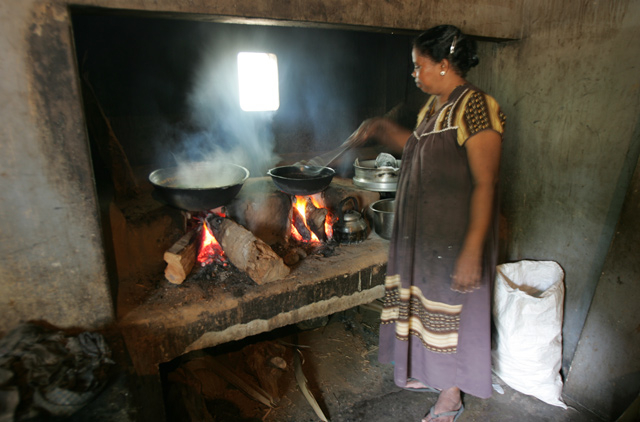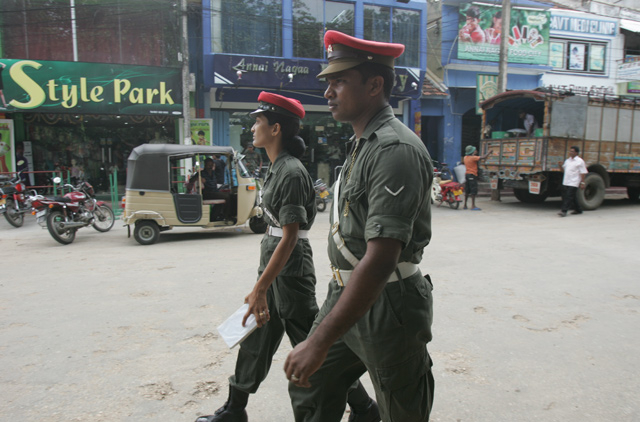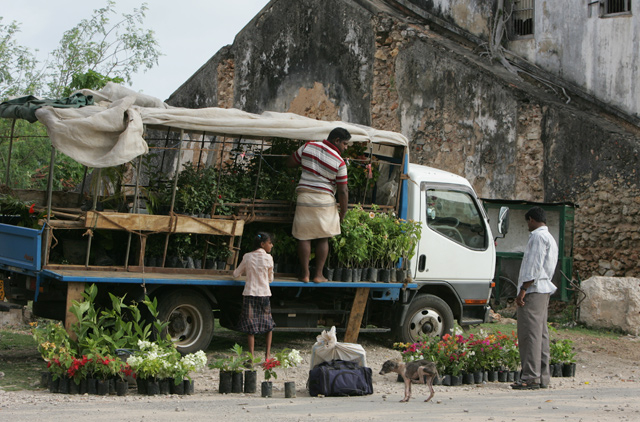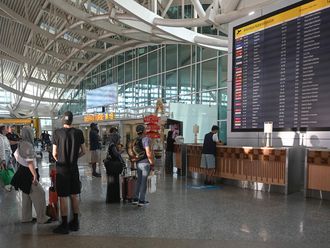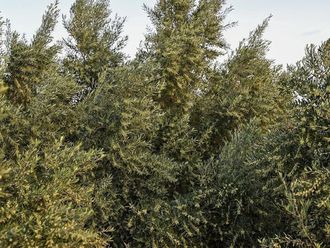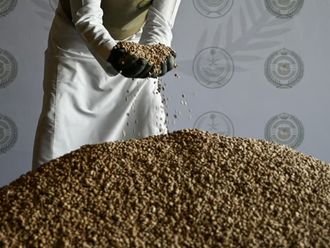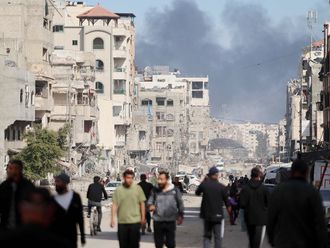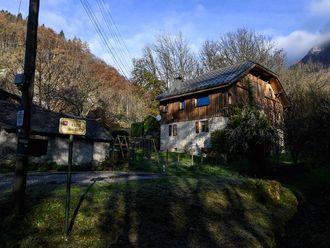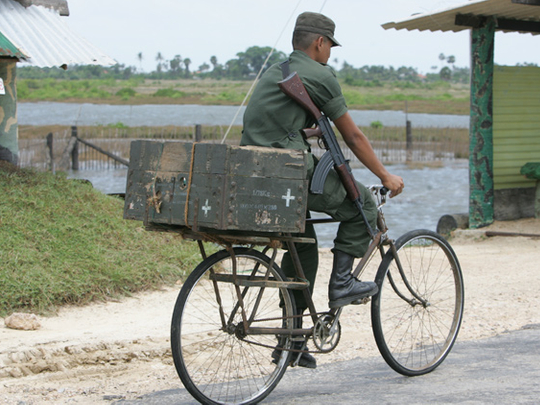
Colombo: A white pelican tucks its long beak into its chest as its perches on top of a lamp post, swaying gently in the stiff wind kicking up white breakers on the deserted beach.
It's warm enough to swim, but swimming is forbidden in Colombo 3 — too close to the Presidential Palace and too close to the Ministry of Defence headquarters at 15/5 Baladaksha Mawatha.
A stream of taxis and three-wheeled autos disgorge a constant trickle of visitors to the military headquarters, but few, if any, get past the heavily guarded main gate of the fortified complex.
It is to this fortified complex that Sri Lankans and all others must come, seeking permission from the military authorities to travel north to Jaffna.
The island's bloody 37-year civil war may be over for 14 months, but restrictions still apply on who and how can journeys to Jaffna be made.
"We are from Jaffna originally," explains Mary, a Tamil Christian who now lives in Australia with her husband, Sylvester. "We still own a home there but it's very difficult for us to get permission to visit."
Shortly after hostilities ended in May, 2009, the couple eventually got permission to visit their home — a place they hadn't seen in a decade.
"We had to fly in by military plane then," says Mary.
This time around, the couple are hoping to get permission to make the 300km journey north by minibus, paying 10,000 Sri Lankan rupees (Dh323) each to travel with three others.
"But we still need to get a letter from the military," Mary says.
Large rusting yellow steel frames cross the entrance to this base, guarded by seven armed military personnel.
Two sentries stand guard in combat webbing, cradling Chinese-made T56 semi-automatic rifles — essentially Beijing's latest version of the ubiquitous AK47 — symbols of the close ties forged between this island nation under the presidency of Mahinda Rajapaske and China.
At the Colombo Hilton earlier that morning, a Deputy Premier of China was being feted as he attended an economic development conference, held also under tight security and behind more large rusting yellow steel frames.
Indeed at most strategic junctions in Colombo, those large rusting yellow steel frames sit on footpaths, forever ready to be pulled across roads as barricades against a terrorist threat.
This is an island under an uneasy peace, where threats of attack are real, and where the administrative mindset is of a nation in the psyche of conflict.
The two sentries carry the markings on their shoulders of the Sri Lankan Air Mobile Brigade, elite troops more used to winning war than keeping peace.
They wear green jump boots on their feet, more casual than the polished black boots worn by the Military Police, Navy Police, Air Force Police and regular troops also guarding this gatehouse.
A white pickup truck approaches and all snap to a crisp salute for the officer in the passenger seat, the driver carefully driving up an open ramp as a soldier in a pit carefully checks the underside of the truck, others checking the back for arms or explosives — anything that might threaten the security of the Ministry of Defence at 15/5 Baladaksha Mawatha.
At the gatehouse, 20 or so civilians wait patiently for letters of approval from military officials. All want to travel to Jaffna. All must supply copies of passports or national identity cards, with detailed travel arrangements and reasons for venturing to the heartland of Sri Lanka's Tamil population.
No excuses given
An overhead fan wobbles as it labours to circulate air for the civilians and the six regular police officers within. A clerk sits behind a wood-wormed desk, diligently filling out a ledger of letters and correspondence coming into the Ministry of Defence.
It is to this clerk that the prospective travellers look for the letters of clearance. He checks a file of letters against their identities, doling out the approvals with the same methodological movements as the disapproved; no excuses given, just a shake of the head.
"We got it," says Mary, heading off with Sylvester arm in arm for the minibus journey to Jaffna.
In neat script the clerk enters the details of the incoming correspondence, most envelopes carry the slogan "On Your Service" and are free of postage stamps: To the Director of Military Intelligence, MoD HQ, addressed from the Embassy of Sri Lanka, Beijing; or to The Director of Military Intelligence from Sri Lanka Air Force HQ.
And then there are the letters of request for military approval to journey to Jaffna.
One elderly Tamil woman sits patiently. This is her fourth day at this gatehouse. So far, nothing. Her daughter lives in a village north of Jaffna town, her son, a dead LTTE fighter.
"Maybe today," she says wistfully. "Maybe tomorrow." She hasn't been home in three years. Another day goes by and still no word on her returning to her village. Her journey to Jaffna is on hold for today.
The phone in the gatehouse rings, answered promptly by a Military Police corporal. The red-capped NCO hands me the phone.
"You can travel to Jaffna," Major Ravindra tells me. "But you cannot travel by road. You must travel by commercial flight."
The letter of permission is on its way to the gatehouse after many faxes, phone calls and pleadings and hours of waiting.
Minutes later, the same red-capped NCO hands over a tersely worded letter of permission, allowing travel on commercial flight between Colombo and Palaly — an air base near Jaffna — only between two specific dates.
There is little room for misinterpreting the instructions and even less flexibility for travelling north.
But commercial flights between Colombo and Palaly do not exist.
There is one flight a day for civilians by military plane and under tight security. And you can't buy a ticket from the military unless you have a letter of permission from the MoD HQ at 15/5 Baladaksha Mawatha.
On the cricket field at Air Force Headquarters bats crack to the incoming balls, a field bounded by razor wire, sandbags and more Air Mobile troops with T56s in hand.
A stern sentry unnerves me, too young and too eager with his weapon, his eyes and actions questioning my presence in this heavily guarded place.
I notice a scar over the bridge of his nose. I mimic it on mine with a bent finger. "Cricket?" I ask.
He looks sternly, then suddenly gets what I'm asking and smiles. "No," he laughs and relaxes. I have just disarmed him mentally.
After two more hours of waiting, an Air Force Captain returns with my passport, letter of permission and a ticket for my journey to Jaffna.
The Sri Lanka Air Force base in Colombo is at Ratmalana, on the opposite end of the sprawling city from Bandaranaike International Airport.
Two Hercules aircraft and a couple of Antropov T32s sit on the runway, a gathering of officers sit in the VIP waiting room, while a gaggle of NCOs and soldiers throng around a miserable canteen kiosk, curious at the civilian in their midst.
"Why you go to Jaffna?" a sergeant asks suspiciously, finding it hard to believe that a foreigner would venture north.
Minefields
"No more LTTE," he says, "But why you want to go there?"
All of the 40 or so men in this waiting area are too on their way to Palaly.
They will wait for another flight. For the three civilians and five officers heading to Palaly this morning, the Sri Lanka Air Force uses an ageing Chinese-built Harbin Y-12 twin prop that coughs to life in a plume of smoke.
The journey to Jaffna by air takes 80 minutes.
By road, it's a dangerous eight-hour drive up the A9 through the heartland of LTTE resistance, past Vavuniya, Mullativu, Kilinochchi and Elephant Pass.
Miles of road, miles of minefields, miles of bombed buildings, pot-marked by shot and shell.
It seems more than a coincidence that this island of 20 million souls stands as a tear falling forever into the Bay of Bengal.
A journey to Jaffna is a trip down years of hatred, war, victory and defeat; deep scars on a landscape; deep wounds on a nation that is struggling to heal.


